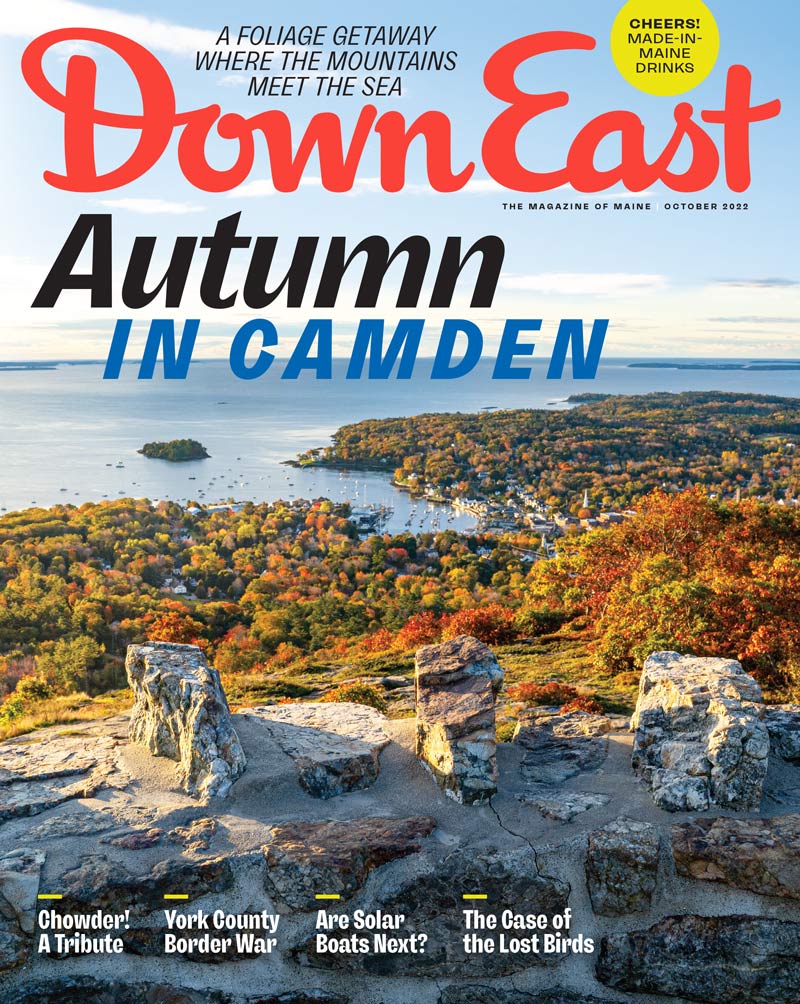Ralston calls this image, shot in 2007, Guardians. He spent hours in the fog shooting these dories, anchored up in a North Haven cove by a territorial fisherman guarding his claim to the inlet should any schools of fish sweep through.
By Philip Conkling
Photograph by Peter Ralston
From our October 2022 issue
Sailors used to say there are two ways of navigating in the fog: facing forward with a Bible or facing aft with a bottle of rum. This navigational suggestion may be apocryphal, but there are numerous accounts of schooner crews along the Maine coast that kept a barrel of potatoes on the foredeck to throw off the bow and listen for a reassuring splash.
The Maine coast has always been at the center of a vortex of fog during the summer — not Carl Sandburg’s little-cat-feet kind but impenetrable gray walls that swallow the whole coast and send their offspring far up the river valleys, into the interior, to spread over us their cool blanket of forgetfulness.
If people of the north have many words for snow, then in Maine, we have many ways of describing fog. There is regular “thick-o-fog,” which covers us like a wet sweater and can linger for days. Then there is pea-soup fog, spooning an even wetter porridge over land and sea. And finally, there is dungeon-thick fog, so dark it feels like late evening at midday. Mariners know these nuances of fog from centuries of navigating the plumes of Maine’s cold coastal currents, which intersect warm humid air from the south in summertime to bring the curtain down on otherwise panoramic views.
My mother-in-law, a proper Massachusetts lady, remembered the first summer she brought her family to the Maine coast for the month of July. She recalled that the first day was sunny and the last day also sunny, with an intervening 29 days of fog, and she was surprised that the family wanted to come back. My father, a southerner, bought a house on the Maine coast for his retirement, but the persistent fogs got to him after three or four years. He sold it and went to Florida.
During a fog mull a number of years ago, the Vinalhaven ferry twice grounded out on ledges at Lairey’s Narrows, a tight, rock-strewn passage between two islands in West Penobscot Bay, where the channel twists and turns. After the second grounding, a local wit erected a large plywood sign with an arrow that read “KEEP LEFT!”
This summer, I wondered where the fog went. Hardly a day of it for three months, from June to August. Day after day, the season’s winds were mostly from the west, blowing over us with their sultry, dry breath from the continental interior.
Are the sunny days of this past summer a harbinger of a warmer future? Hard to know, but increased sea-surface temperatures in the Gulf of Maine have been a persistent feature for the past decade, and 2021 was the warmest year on record for our corner of the Atlantic Ocean — about 7 percent higher than the long-term average, according to the Gulf of Maine Research Institute.
If you are a rental agent peddling properties to people from away, or a sun lover who does not appreciate the interiority that fog brings, this summer was a blessing. If you wish swimming on the Maine coast was not such a character-building experience, the rapidly warming waters in the Gulf of Maine may seem salubrious at first. But I suspect that most of us would prefer the old days of fog to drought, which is what the warmer winds of spring and summer have brought to most of Maine during the past season. Parched brown fields, dusty rows between furrows, and tinder-dry woods are high prices for many of us to pay for a few more days of sun and fun for visitors to Vacationland.




